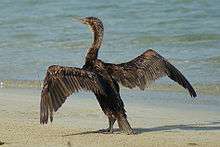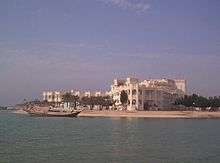Hawar Islands
| Native name: <span class="nickname" ">Arabic: جزر حوار | |
|---|---|
 Hawar Islands Location of Hawar Islands in Bahrain | |
| Geography | |
| Location | Persian Gulf |
| Coordinates | 25°36′N 50°46′E / 25.60°N 50.77°ECoordinates: 25°36′N 50°46′E / 25.60°N 50.77°E |
| Archipelago | Bahrain |
| Adjacent bodies of water | Persian Gulf |
| Total islands | 16[1] |
| Major islands |
|
| Area | 52 km2 (20 sq mi) |
| Highest elevation | 22 m (72 ft) |
| Administration | |
| Governorate | Southern Governorate, ISO Code BH-14 |
| Additional information | |
| Time zone | |
The Hawar Islands (Arabic: جزر حوار; transliterated: Juzur Ḩawār) is an archipelago of desert islands owned by Bahrain, situated off the west coast of Qatar in the Gulf of Bahrain of the Persian Gulf.
Description
The islands used to be one of the settlements of the Bahraini branch of the Dawasir who settled there in the early 19th century.[2] The islands were first surveyed in 1820, when they were called the Warden’s Islands, and two villages were recorded.[3] They are now uninhabited, other than a police garrison and a hotel on the main island; access to all but Hawar island itself is severely restricted. Local fishermen are allowed to fish in adjacent waters and there is some recreational fishing and tourism on and around the islands.[4] Fresh water has always been scarce; historically it was obtained by surface collection and even today, with the desalinisation plant, additional supplies have to be brought in.[3]
Geography
Despite their proximity to Qatar (they are only about 1 nautical mile (1.9 km) from the Qatari mainland whilst being about 10 nautical miles (19 km) from the main islands of Bahrain),[5] most of the islands belong to Bahrain, having been a part of a dispute between Bahrain and Qatar which was resolved in 2001.[6] The islands were formerly coincident with municipality or Minţaqat Juzur Ḩawār (مِنْطَقَة جُزُر حَوَار) and are now administered as part of the Southern Governorate of Bahrain. The land area of the islands is approximately 52 km2.[7]
Although there are 36 islands in the group,[8] many of the smaller islands are little more than sand or shingle accumulations on areas of exposed bedrock molded by the ongoing processes of sedimentation and accretion. The WHS application named 8 major islands (see table hereafter), which conforms to the description of the islands when first surveyed as consisting of 8 or 9 islands.[9] It has often been described as an archipelago of 16 islands.[1] Janan island, to the south of Hawar island, is not legally considered to be a part of the group and is owned by Qatar.[10]

Flora and Fauna
The islands are home to many bird species, notably Socotra cormorants. There are small herds of Arabian oryx and sand gazelle on Hawar island, and the seas around support a large population of dugong.[11]
Conservation
The islands were listed as a Ramsar site in 1997.[8] In 2002, the Bahraini government applied to have the islands recognised as a World Heritage Site due to their unique environment and habitat for endangered species;[3] the application was ultimately unsuccessful.[7]
Administration
The islands were formerly coincident with municipality or Minţaqat Juzur Ḩawār (مِنْطَقَة جُزُر حَوَار) and are now administered as part of the Southern Governorate of Bahrain.[7]

Tourism
In 2014, a Best Western hotel with 140 rooms replaced a much smaller Hawar Islands Resort.[12][13] However, the resort closed in mid-2016.
List of islands
Hawar archipelago
By far the largest island is Hawar, which accounts for more than 41 km2 of the 54.5 km2 land area.[7] Following in size are Suwād al Janūbīyah, Suwād ash Shamālīyah, Rubud Al Sharqiyah, Rubud Al Gharbiyah, and Muhazwarah (Umm Hazwarah).
| Name | Arabic | Coordinates | Max height (meters) | Comments |
|---|---|---|---|---|
| Hawar | جَزِيرَة حَوَار | 25°39′19″N 50°44′58″E / 25.65528°N 50.74944°E | 22.0[14] | The island is 18 km long and varies in width from 5.2 to 0.9 km.[15] Continuous beach ridge complex west coast, sloping bedrock rising west to east. Complex bay and cliff formations east coast fronted in places by subqa, jebel and terminals of east lower headlands aeolian formations calcified reef structures and algal mats.[14] |
| Suwād al Janūbīyah | سُوَاد اَلْجَنُوبِيَّة | 25°38′33″N 50°47′59″E / 25.64250°N 50.79972°E | 4.0[14] | South Suwad. Sand and shingle accumulations, subqa and salt encrusted flats with areas of exposed surface rock, beach rock to the north. Mud, shoals and shallow to south, blown sand beaches.[14] Host to a large Socotra cormorant colony, representing over 10% of the world population.[3] |
| Suwād ash Shamālīyah | سُوَاد اَلشَّمَالِيَّة | 25°40′29″N 50°48′36″E / 25.67472°N 50.81000°E | 3.0[14] | North Suwad. Sand and shingle accumulations, subqa and salt encrusted flats, areas of beach rock to north, shoals and shallow to south and southeast, wind blown sand, beaches.[14] |
| Rubud Al Sharqiyah | رَبَض اَلشَّرْقِيَّة | 25°45′03″N 50°46′54″E / 25.75083°N 50.78167°E | 0.8[14] | East Rubud. Sand and shingle accumulations, subqa and salt encrusted flats, storm beach north and northeast, mudflats, shoals and shallow lagoons south and east large areas of beach rock and reef. Islands off exposed beach rocks & vegetated islets.[14] Significant western reef heron colony.[3] |
| Rubud Al Gharbiyah | رَبَض اَلْغَرْبِيَّة | 25°45′07″N 50°45′58″E / 25.75194°N 50.76611°E | 1.0[14] | West Rubud. Sand and shingle accumulations, subqa and encrusted flats, storm beach north and west, mudflats, shoals and shallow lagoons south and east. Islands off exposed beach rocks & vegetated islets.[14] Significant western reef heron colony.[3] |
| Muhazwarah (Umm Hazwarah) | 25°39′46″N 50°46′28″E / 25.66278°N 50.77444°E | 12.5[14] | Rock (exposed strata), undercut cliffs, small sand or shingle beaches, raised marine terraces with sand spit southern aspect sand accumulations behind. Centre open wadi with rim rocks.[14] | |
| Umm Jinni | 25°40′31″N 50°47′05″E / 25.67528°N 50.78472°E | 0.5[14] | Sand and shingle accumulations with areas of beach rock shoals and shallow lagoons surrounding.[14] | |
| Ajirah | جَزِيرَة عَجِيرَة | 25°44′24″N 50°49′24″E / 25.74000°N 50.82333°E | 7.0[14] | Rock (exposed strata), undercut cliffs and areas of beach rock and reefs. Single marine terrace with sand spit southwest sand and shingle accumulations behind.[14] |
| Bū Sadād (Bu Sa’adad) (group) | جُزُر بُو سَدَاد | 25°37′31″N 50°46′37″E / 25.62528°N 50.77694°E | 2.0[14] | Sand and shingle accumulations with areas of beach rock, shoals and shallow lagoons surrounding. Storm beaches northern aspects. Islands off ‑ various with mud sand and exposed rocky vegetated islets.[14] |
| Al Hajiyat (group) | 25°42′00″N 50°48′00″E / 25.70000°N 50.80000°E | 7.5[14] | Group of 3 islands.[8] Rock (exposed strata), undercut cliffs terraced, small sand or shingle beaches, reefs.[14] | |
| Al Wukūr (Al Wakur) (group) | جُزُراَلْوُكُور | 25°39′13″N 50°48′54″E / 25.65361°N 50.81500°E | 10.0[14] | Isolated sea stacks with shingle beaches with surrounding shallow lagoon.[14] |
| Bu Tammur (group) | 25°37′00″N 50°47′00″E / 25.61667°N 50.78333°E | 1.5[14] | Isolated undercut heavily fossilized rock platforms.[14] |
The following were not considered as part of the Hawar islands in the International Court of Justice (ICJ) judgment, being located between Hawar and the Bahrain Islands and not disputed by Qatar, but have been included in the Hawar archipelago by the Bahrain government as part of the 2002 World Heritage Site application.[3][16]
| Name | Arabic | Coordinates | Max height (meters) | Comments |
|---|---|---|---|---|
| Jazīrat Mashtān (Mashtan) | جَزِيرَة مَشْتَان | 25°48′22″N 50°40′54″E / 25.80611°N 50.68167°E | Northernmost island and the closest to Bahrain Island. Roughly equidistant between there and the northernmost of the Hawar islands, Rubud Al Gharbiyah. Although very small at high tide, at low tide Mashtan is considerably larger.[17] | |
| Al Mu`tariḑ | اَلْمُعْتَرِض | 25°47′12″N 50°42′51″E / 25.78667°N 50.71417°E | A reef south-east of Mashtan.[3] Location of the largest sighting of dugong in the area.[18] | |
| Fasht Bū Thawr (Bu Thur) | فَشْت بُو ثَوْر | 25°48′00″N 50°46′00″E / 25.80000°N 50.76667°E | A low-tide elevation coral reef approximately 100 m long.[3] |
Janan island
Janan island, a small island south of Hawar island, was also considered in the 2001 ICJ judgment. Based on a previous agreement when both Qatar and Bahrain were under British protection, it was judged to be separate from the Hawar islands and so considered by the court separately.[10] It was awarded to Qatar.[6]
| Name | Arabic | Coordinates | Max height (meters) | Comments |
|---|---|---|---|---|
| Jazīrat Jinān (Janan) | جَزِيرَة جَنَان | 25°33′29″N 50°44′06″E / 25.55806°N 50.73500°E | A small island (or islands, if the low tide elevation of Hadd Janan is counted separately), 1.6 nautical miles (3.0 km) south of Hawar Island. It measures approximately 700 m by 175 m and with a total surface area of around 0.115 km2.[19] |
References
- 1 2 "Case concerning Maritime Delimitation and Territorial Questions between Qatar and Bahrain" (PDF). ICJ. 9 June 2000. p. 28.
- ↑ "Case concerning Maritime Delimitation and Territorial Questions between Qatar and Bahrain" (PDF). ICJ. 16 March 2001. p. 44.
- 1 2 3 4 5 6 7 8 9 "Nomination file: The Hawar Archipelago". Government of Bahrain. 11 June 2002.
- ↑ "Bahrain" (PDF). Ramsar Convention. p. 11.
- ↑ International Maritime Boundaries : vol. IV. American Society of International Law. 2002. p. 2844. ISBN 904111954X.
- 1 2 "Case concerning Maritime Delimitation and Territorial Questions between Qatar and Bahrain" (PDF). ICJ. 16 March 2001. p. 81.
- 1 2 3 4 "IUCN Evaluation of Nominations of Natural and Mixed Properties to the World Heritage List". Hawar-Islands.com. 2004.
- 1 2 3 Hawar Islands Protected Area: Management Plan (PDF). January 2003.
- ↑ "Case concerning Maritime Delimitation and Territorial Questions between Qatar and Bahrain" (PDF). ICJ. 13 June 2000. p. 12.
- 1 2 "Case concerning Maritime Delimitation and Territorial Questions between Qatar and Bahrain" (PDF). ICJ. 16 March 2001. p. 54.
- ↑ "Bahrain" (PDF). Ramsar Convention. p. 12.
- ↑ "Best Western to open Bahrain resort next month". Trade Arabia. 15 January 2014.
- ↑ "Best Western Unveils Arabian Island Retreat". Best Western. 19 November 2014.
- 1 2 3 4 5 6 7 8 9 10 11 12 13 14 15 16 17 18 19 20 21 22 23 24 "Bahrain Bird Report". Hawar-Islands.com.
- ↑ "An archaeological survey of Hawar Island". Arabian Archaeology and Epigraphy. November 2001. p. 143.
- ↑ Hawar Islands Protected Area: Management Plan (PDF). January 2003. p. 10 (map).
- ↑ "Case concerning Maritime Delimitation and Territorial Questions between Qatar and Bahrain" (PDF). ICJ. 16 March 2001. p. 61.
- ↑ "Dugong". Hawar-Islands.com.
- ↑ "Case concerning Maritime Delimitation and Territorial Questions between Qatar and Bahrain" (PDF). ICJ. 16 March 2001. p. 49.
External links
| Wikimedia Commons has media related to Hawar Islands. |
Maps
- Basic map with island names and features, p. 3
- Topographical map
- Geological map
- Navigation chart, Bahrain & Hawar
- Aerial photograph
Media
- Bahrain Desert Birds, BBC Planet Earth. Taken from "Shallow Seas" (2006).